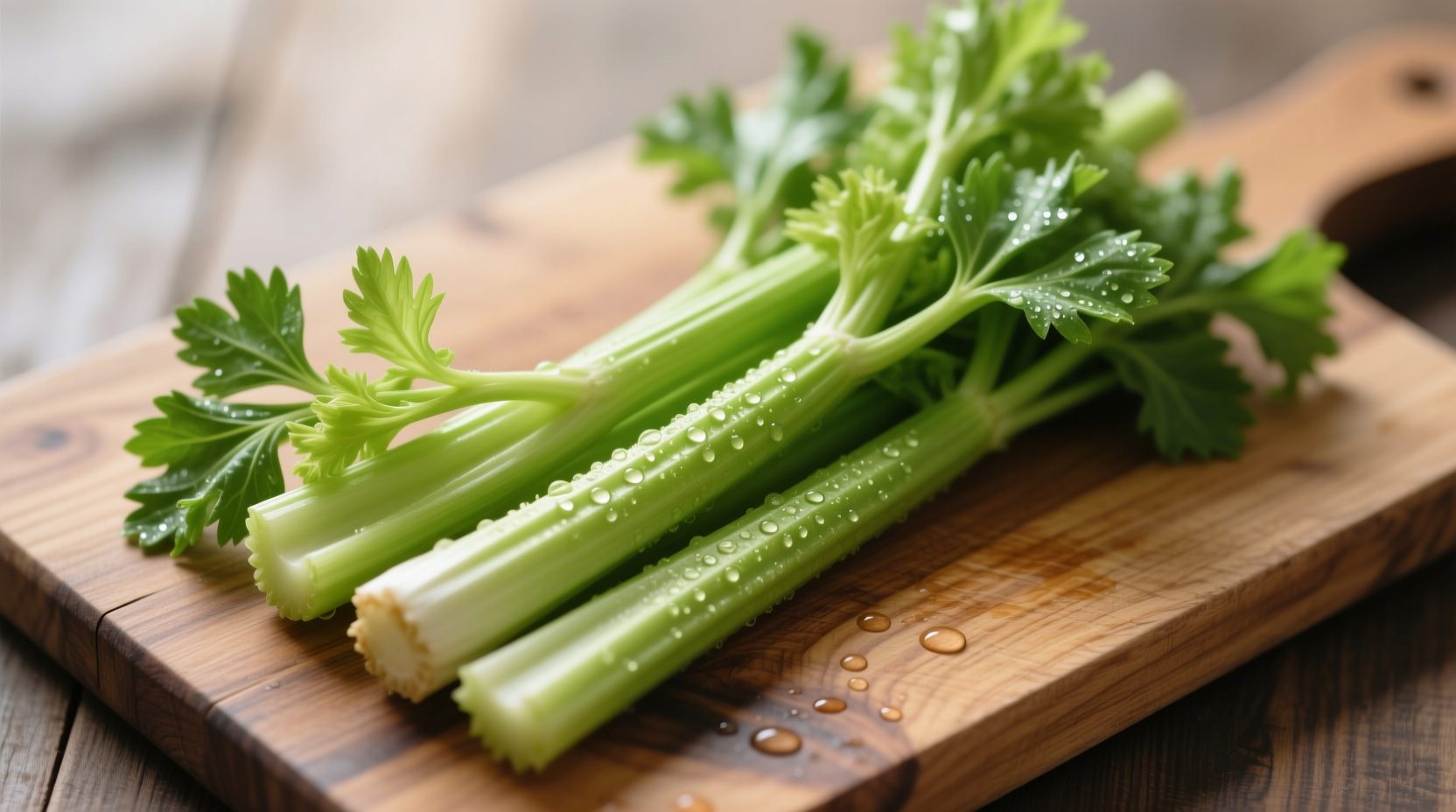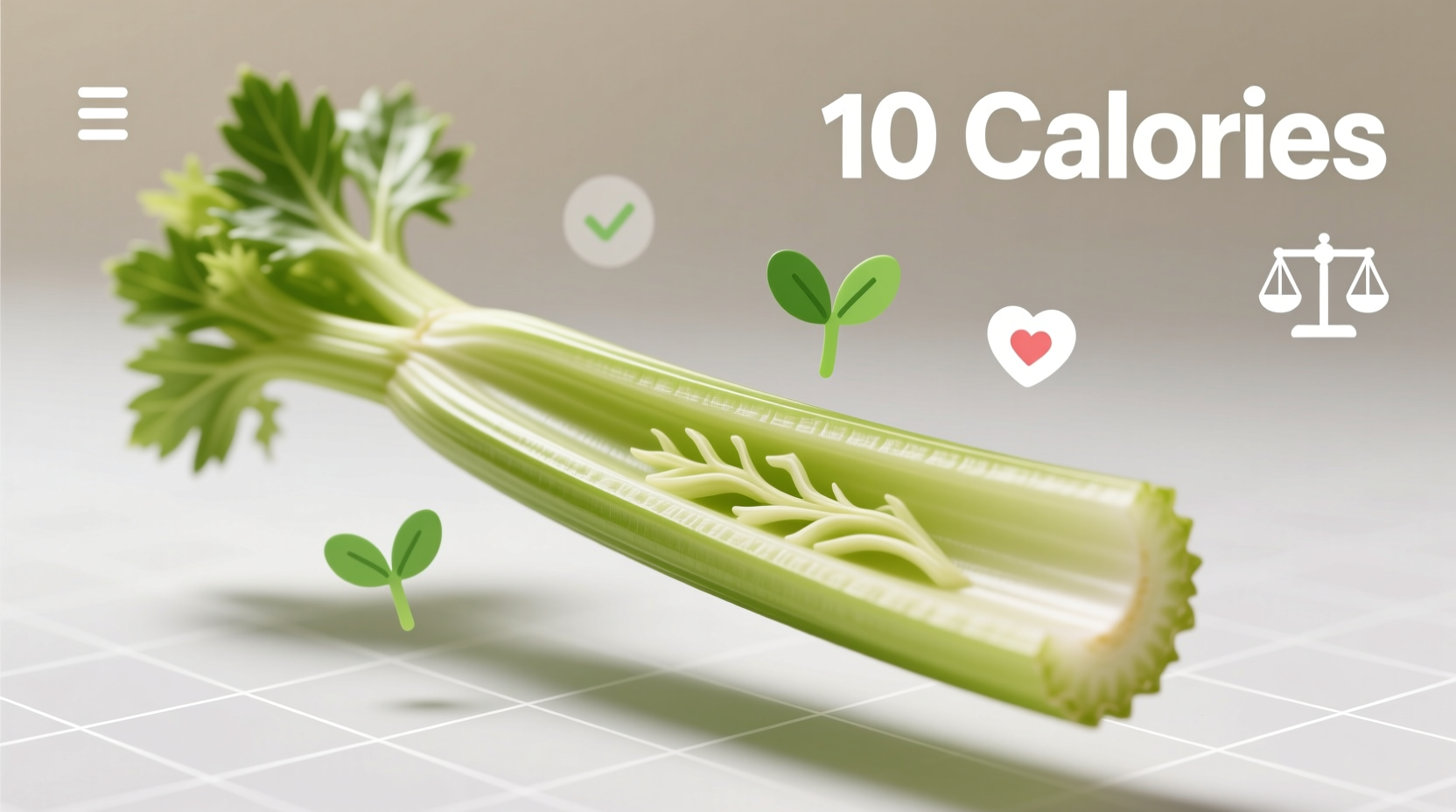When you're tracking your daily calorie intake or looking for nutrient-dense, low-calorie food options, celery stands out as an exceptional choice. This crisp, refreshing vegetable has earned its reputation as a diet-friendly staple for good reason. Understanding the precise caloric content of celery helps you make informed decisions about incorporating it into your nutrition plan.
Exact Calorie Count: Breaking Down the Numbers
The United States Department of Agriculture (USDA) FoodData Central provides the most reliable nutritional information for celery. According to their comprehensive database, the calorie content varies slightly based on serving size:
| Serving Size | Calories | Carbohydrates | Water Content |
|---|---|---|---|
| 1 medium stalk (40g) | 6 | 1.2g | 35g |
| 1 cup chopped (100g) | 16 | 3g | 95g |
| 1 cup diced (110g) | 18 | 3.3g | 105g |
This data comes directly from the USDA FoodData Central, the authoritative source for nutritional information in the United States. The exceptionally high water content (approximately 95%) explains why celery is so low in calories while still providing volume and crunch.
Why Celery's Calorie Count Matters for Your Diet
Many people wonder about the "negative calorie" concept often associated with celery. While the thermic effect of food (calories burned during digestion) for celery is minimal, its extremely low caloric density makes it an excellent choice for:
- Volume eating strategies for weight management
- Hydration support without added sugars
- Crunchy snack alternatives to high-calorie options
- Adding bulk to meals while minimizing calorie intake
Registered dietitians consistently recommend celery as part of balanced eating patterns because you can consume a substantial volume without significantly impacting your daily calorie goals. For context, you would need to eat approximately 10 medium stalks of celery to reach 60 calories—providing significant volume and nutrients for minimal caloric cost.

Nutritional Benefits Beyond Calories
While the calorie count draws attention, celery offers valuable nutrients that contribute to overall health:
- Vitamin K: One cup provides about 30% of your daily needs for blood clotting and bone health
- Potassium: Supports healthy blood pressure levels
- Dietary fiber: Aids digestion and promotes satiety
- Antioxidants: Contains flavonoids and vitamin C for cellular protection
These nutritional components work synergistically with celery's low calorie count to create a food that supports multiple aspects of health beyond just weight management. Research published in the Journal of Agricultural and Food Chemistry confirms celery's phytochemical profile contributes to its health-promoting properties.
Practical Applications in Meal Planning
Understanding how to effectively incorporate celery into your diet maximizes its benefits:
- Snacking smart: Pair celery sticks with 1 tablespoon of natural peanut butter (95 calories) for a satisfying snack totaling approximately 100 calories
- Meal volume booster: Add chopped celery to soups, stews, and salads to increase portion size without significant calorie addition
- Hydration helper: Use celery in infused water recipes for flavor without sugar or calories
- Crunch replacement: Substitute celery for higher-calorie crunchy snacks when craving texture
Registered dietitians emphasize that celery's true value comes from how it fits into your overall dietary pattern rather than any single nutritional attribute. When tracking calories on celery specifically, remember that preparation methods affect the total calorie count—adding dressings, dips, or cooking with oils significantly increases the caloric value.
Common Misconceptions About Celery Calories
Several myths persist about celery's caloric content that deserve clarification:
- The "negative calorie" myth: While celery requires some energy to digest, the thermic effect doesn't exceed its caloric content. However, its extremely low calorie density still makes it an excellent choice for weight management.
- Organic vs. conventional calorie count: Whether organic or conventionally grown, celery's caloric content remains virtually identical.
- Stalk vs. leaves: Celery leaves contain slightly more nutrients but similar calorie content per weight compared to stalks.
The Centers for Disease Control and Prevention (CDC) confirms that non-starchy vegetables like celery should form a substantial part of any healthy eating pattern, regardless of specific calorie counting approaches.
How Celery Compares to Other Low-Calorie Vegetables
When evaluating calories on celery in context, it's helpful to compare with similar vegetables:
- Cucumber: 16 calories per cup
- Zucchini: 20 calories per cup
- Spinach: 7 calories per cup (raw)
- Broccoli: 31 calories per cup
While spinach has fewer calories per cup, celery's crunchy texture makes it uniquely valuable as a snack replacement for higher-calorie crunchy foods like chips or crackers. This practical application often makes celery more useful in specific dietary contexts despite similar caloric profiles to other vegetables.
Using Calorie Information for Realistic Weight Management
Understanding the precise calorie count of celery helps set realistic expectations for weight management. While no single food causes weight loss, incorporating low-calorie, high-volume foods like celery can create a sustainable calorie deficit when part of an overall balanced approach.
Nutrition professionals emphasize that focusing solely on calories on celery misses the bigger picture—its value comes from how it helps you feel satisfied while consuming fewer total calories throughout the day. The fiber and water content contribute to satiety, potentially reducing overall calorie intake at subsequent meals.
Frequently Asked Questions
How many calories are in a cup of celery?
One cup of chopped celery (approximately 100g) contains about 16 calories according to USDA FoodData Central. This serving provides significant volume with minimal caloric impact, making it ideal for weight management strategies.
Does celery really have negative calories?
No, celery does not have "negative calories." While it requires some energy to digest, the thermic effect of food doesn't exceed its caloric content. However, with only 6 calories per medium stalk, celery's extremely low caloric density makes it an excellent choice for creating volume in meals without significant calorie addition.
How does celery compare to other vegetables for weight loss?
Celery ranks among the lowest-calorie vegetables available, with only 16 calories per cup. Its high water content (95%) and crunchy texture make it particularly valuable as a snack replacement for higher-calorie crunchy foods. While other vegetables like spinach and cucumbers have similar calorie counts, celery's unique texture provides satisfaction that helps reduce overall calorie intake throughout the day.
Does the calorie count change if I cook celery?
The calorie count of plain cooked celery remains virtually identical to raw celery. However, cooking methods that add fats or sauces significantly increase the total calories. For example, celery cooked with butter or in a creamy soup will have substantially more calories than raw celery sticks. The base vegetable itself maintains its low-calorie profile regardless of preparation method.











 浙公网安备
33010002000092号
浙公网安备
33010002000092号 浙B2-20120091-4
浙B2-20120091-4